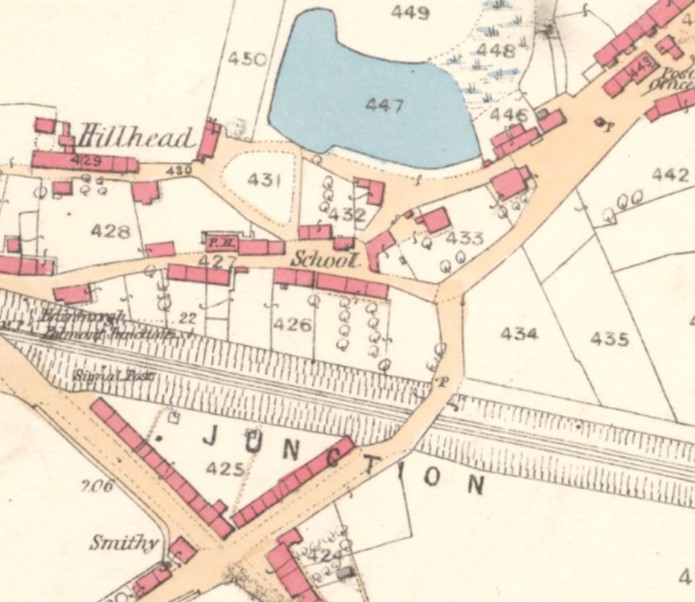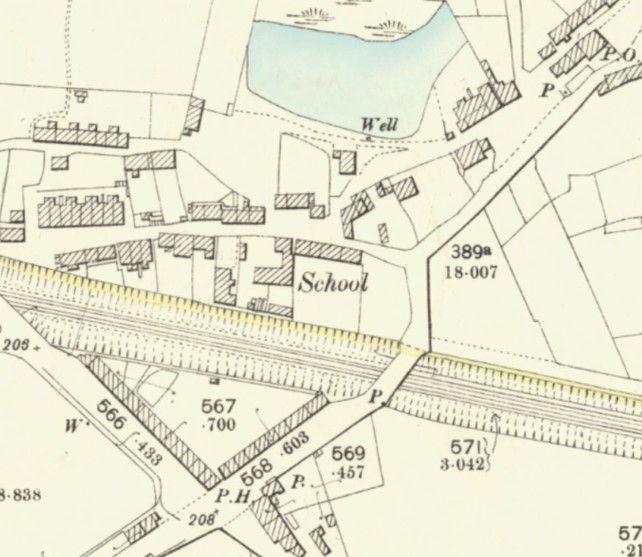Just when the village school at Redding was founded is obscure but we do know that it was a subscription school set up by the feuars of Redding. A date of around 1830 is probable. The salary was sufficient to attract men of the calibre of Mr Carse as the teacher. He was there in 1849 when he sought and received permission for his pupils to visit the grounds of the mansions at Westquarter and Callendar as part of the history lessons. By 1856 he had moved to Kinnaird.
A teacher was sought in 1859 and an advert was duly placed in the local newspaper:
“WANTED, A TEACHER for the VILLAGE SCHOOL of REDDING, near Falkirk. The emoluments consist of School Fees, and an annual salary of £10. There is Dwelling-house and large Garden. At present the attendance is about 70, and the fees run from 2s 6d to 4s per quarter. Applications, with testimonials, to be sent to Mr Robert Mitchell, Redding, by Falkirk, on or before 15th October. The Teacher will be required to enter on his duties immediately after election.”
(Falkirk Herald 6 October 1859, 1).

The school building stood on the south side of a road which became known as “School Road.” Redding Square, the centre of the village, lay just to its south, and a small loch (now a park) to the north. In the early 1850s the Midland Junction Railway was driven through the area, separating the school from the square.
The Ordnance Surveyors in 1860 describe it as:
“A small private school situated in the Redding village, and where the ordinary branches are taught. Average number of scholars about sixty. There is no government allowance or endowment attached to the school, the master receiving only the fees and £10 by subscription, in all £46 a year. The house is slated, one storey and in good repair. Property of various individuals.”
With the formation of the Polmont School Board in 1873 the Redding feuars intimated that they were ready to hand over their school. The title deeds were inspected and one clause in the disposition by Sir Thomas Livingstone caused some consternation. It was to the effect that the feuars could not apply the house and property to any purpose other than those of a school, to be filled by a teacher chosen by a majority of the feuars. This was similar to the fourth clause of the Free Church offer to the School Board that had made that offer unworkable. Experience had taught the Board to investigate further and seek an opportunity for the superior to alter such conditions. The feu duty was only 1/12th penny; but an annual sum of £2 was claimed by the feuars for the upkeep of the wells in the village. The Board looked at the buildings and concluded that the school was reasonably substantial but the adjoining house was hardly habitable.
The Board was able, with the blessing of the Education Department, to take over the management and property of the school. The building was tiny and so in 1875 tenders were invited to extend it to the south:
“To Contractors, the School Board of the Parish of Polmont are prepared to receive tenders for the Mason, Joiner, Plaster, Slater, and Plumber Works of ADDITIONS to and ALTERATIONS on the REDDING VILLAGE SCHOOL, and a New TEACHER’s HOUSE.
Plans and Specifications may be seen in the hands of the Architect, T. B. M’Fadzen, 19 At Andrew Square, Edinburgh, or the Clerk, Andrew Allan, Solicitor, The Cross, Falkirk, with the latter of whom sealed offers, marked “Tender for Redding Village School,” are to be lodged on or before the 16th June 1875.”
(Falkirk Herald 10 June 1875, 1).

Building work took place over the summer of 1876 and the enlarged school re-opened on 25 September that year with a new headmaster, John Biggar. The school was very conveniently located for the village and the teacher was much appreciated. As a consequence the school soon became overcrowded. In June 1883 the Education Department sent a letter to the Polmont School Board pointing out the deficiency of the accommodation and stating that
“the average attendance must no longer exceed the number for whom accommodation is provided, otherwise next year’s grant may be seriously endangered.”
The threat of a financial penalty was sufficient to push the School Board into deciding to increase the accommodation by 65 pupils or thereby, and it appointed William Black, architect, Falkirk, to prepare a plan. This created a west/east wing at the south of the earlier extension.
This was sufficient for the moment but within a decade things were just as bad. To relieve the situation some 75 pupils were told to go to other schools in the area. Most of these lived south of the Union Canal and other schools were available. However, the parents raised a petition. The School Board delayed action until a situation regarding Reddingmuirhead School was resolved and in 1897 resolved rather than fix Reddingmuirhead School it would build a new one in the Brightons area. On 1 November 1898 Wallacestone School was opened and Reddingmuirhead School was closed. This led to a big shake-up of staff. The staff of the new school was fixed as follows: Mr Biggar, headmaster; Miss Learmonth, and Misses Williamson, Gardner, and Edwards, and Mr John Russell, from the Redding Village School; Miss Hay from the Polmont Female School; and Miss Liddle and Mr G. B. Brown, from Reddingmuirhead School. The staff for the Redding Village School was rearranged as follows:—Mr Loudon, headmaster; Miss Hamilton and Miss Tripney. from Reddingmuirhead School; and Miss Bella Roughhead, from Polmont Public School; together with a certificated teacher to be appointed.
Even after the opening of Wallacestone School on 1 November 1898 the school at Redding Village remained overcrowded. This state of affairs continued for some time and in 1907 30 pupils were transferred to Redding School which was only a short distance to the south. By then Redding Village School had become an infant school with a headmistress in charge.
The school was now part of the Grangemouth School Board’s remit and it had to deal with more pressing priorities. In 1933 Stirling County Council was in charge and looked at the options available. The school was hemmed in by other buildings and by the railway to the south. The old properties adjoining were not considered to be suitable for school use. In 1937 it was decided to construct a large school in the newly planted model village at Westquarter and to close that at Redding Village. Consequently, when the headmistress at Redding Village School retired in 1938, she was not replaced and the school was put under the charge of the headmaster of Redding School. Unfortunately for these best laid plans the school at Westquarter was requisitioned by the RAF just before it was due for completion in 1939. Various buildings, including the Redding Village School, had to cover the gap which occurred before Westquarter was handed back. In 1944 it was emphatically stated that Redding Village School should not be used for teaching purposes. It could be used as a youth centre, as a community centre, or as a store for furniture. The latter of these came about.
The school buildings and the neighbouring dwellings were swept away in the late 1950s and by 1965 the area was occupied by new council houses.
| YEAR ARRIVED | HEADTEACHER | YEAR LEFT | No. PUPILS |
|---|---|---|---|
| (1849) | Mr Carse | 1852? | |
| 1859 | |||
| 1876 | John W Biggar | 1898 | 55, 190, 210 |
| 1898 | Mr Louden | 1903 | |
| 1903 | Miss M W Whyte | ||
| 1908 | Miss Robertson?? | ||
| 1910 | Miss Somerville | 1919 | |
| (1923) | Miss J Harrower | 1938 |
Sites and Monuments Record
| School Road | SMR 2305 | NS 9177 7849 |
